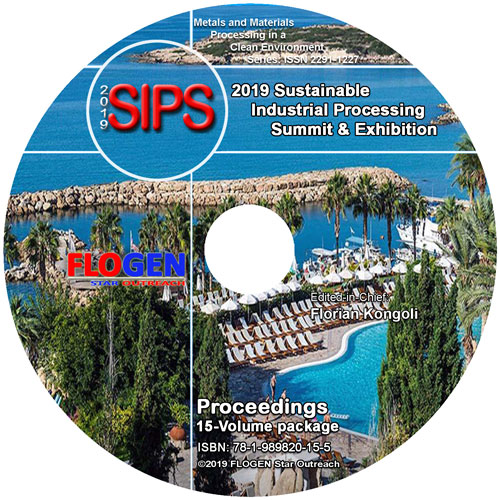2019-Sustainable Industrial Processing Summit
SIPS2019 Volume 8: Usui Intl. Symp. / Advanced Sustainable Iron and Steel Making
| Editors: | F. Kongoli, P. Assis, M.C. Gomez-Marroquin, S. Kitayama, H. Konishi, A. Murao, S. Nomura, H. Ono, H. Saxen, K. Seto, J.I. Tani |
| Publisher: | Flogen Star OUTREACH |
| Publication Year: | 2019 |
| Pages: | 250 pages |
| ISBN: | 978-1-989820-07-0 |
| ISSN: | 2291-1227 (Metals and Materials Processing in a Clean Environment Series) |

CD shopping page
Hydrogen Shaft Furnace Process Using Bio-Self-Reducing Agglomerates
Jose Adilson de Castro1; GIULIO ANTUNES DE MEDEIROS2; Jonni Guiller Ferreira Madeira3; Elizabeth Oliveira4; Marcos de Campos1;1UFF - FEDERAL FLUMINENSE UNIVERSITY, Volta Redonda, Brazil; 2UFF-PROGRAMA DE POS GRADUAçãO EM ENGENHARIA METALURGICA, Volta Redonda, Brazil; 3CEFET-ANGRA DOS REIS, Angra dos Reis, Brazil; 4CENTER FOR TECHNOLOGICAL EDUCATION CELSO SUCKOW DA FONSECA, Valenca, Brazil;
Type of Paper: Keynote
Id Paper: 206
Topic: 2
Abstract:
The reduction of pellets and lump ores in the shaft furnace process is widely used to produce direct reduced iron (DRI). The traditional process of DRI production uses a gas reforming system based on catalytic reactions and demands high amount of fossil source energy from natural gas. A new hydrogen-based process has been proposed. In this study, we propose to combine self-reducing characteristics with hydrogen technology with self-catalytic reactions to avoid the natural gas-based reforming step. We analyzed this new technology using an in-house computational code. The computational analysis is a numerical model based on transport equations of momentum, energy and chemical species for gas and solid phases to reproduce the inner phenomena in the direct reduction of the shaft furnace process for producing DRI. The model is used to investigate promising scenarios of hydrogen-based technology. Four cases were considered using partial replacement of the burden by bio-self-reducing agglomerates combining with hydrogen and oxygen injections on the bustle level. The inner temperature, pressure and phase composition distributions are discussed for the selected scenarios. The simulation results indicated that the efficiency of the process can be improved with the adequate choice of operational parameters and raw materials burden.